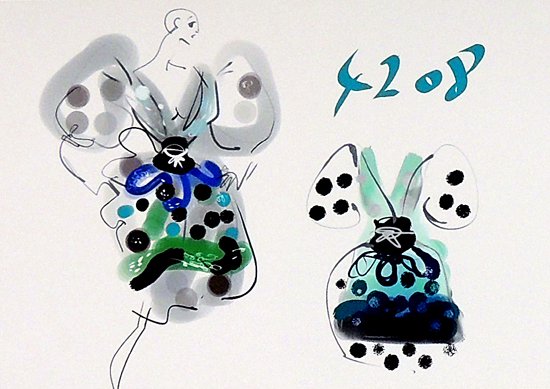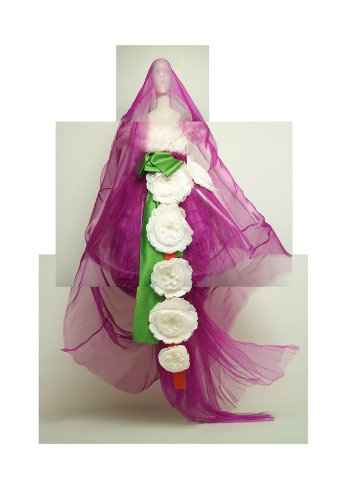
67 drawings were presented in 2008 for the exhibition Musée Réattu, Christian Lacroix, The former fashion designer is now entrusting them to the Musée Réattu. They span his whole career at the head of his haute couture fashion house that was created in 1987.
The ensemble consists of two types of drawings. The first type comprises sketches from the eighties and nineties, produced in ballpoint pen, felt-tip pen, colour pencil, gouache and watercolour on waste paper: hotel notepads, photocopies from magazines etc. These drawings support the establishment of his now iconic style, partly based on a palette where the dullest, as well as the brightest, the flattest, as well as the most violent colours are encouraged. References to Arles, to Camargue and the early baroque look are documented in very free drawings, sometimes accompanied by written instructions for studio originals.
The second type encompasses designs from the 2000s. These were increasingly dominated by the use of computers and a graphic palette, and accompany this transformed style that were then expressed in a more abstract, free and incisive way, supported by colours that turn from golden yellow to Post-it yellow and from fuchsia pink to Stabilo pink.
This loan arises from the very active steps taken to make his work part of heritage. Thus the drawings and models for the performing arts have been allocated to the collections of the Centre National du Costume de Scène de Moulins (of which he is honorary president) while his personal archives– collages, ‘mood-board’, work documents–have been received by the Museon Arlaten in 2014. The free drawing portion therefore returns to Musée Réattu, in order to complement the discourse around the notion of work in progress, an important part of the museum’s acquisition policy.
In agreement with Galerie Lelong in Paris, representing the interests of the artist in France, the Miró estate has offered to loan a bronze by Joan Miró called La femme à la chevelure défaite, to the Musée Réattu for five years.
The sculpture, featuring rather late in the work of the artist, does however fully represent an important part of his creation within which the female maintains a central place, the theme of women and hair having gone through many changes.
Dated 1975, La femme à la chevelure is almost contemporary to the Picasso donation kept by the Musée Réattu. This face with a very visual profile, with a strongly emphasised eye, thus fits in perfectly in relation to the many portraits of men and women left by the artist from Andalucia.

In 1990 the relationship between Pierre Alechinsky and the Musée Réattu materialised with the first acquisition of a work, Érosion éolienne, a painting mindful of the concept of a Mediterranean landscape composed of shadow, light and wind, that the artist regularly saw from his studio in Paradou, in the Alpilles. This purchase was immediately accompanied by his donation of Soleil tournant, a painting that returns here to its geographical origins, as it was in Arles that the Belgian artist produced his first rubbings of manhole covers, destined for many developments around the world. The collection then develops considerably with the donation of the series Al Alimon: twelve works produced mano a mano by Alechinsky and his friend Alberto Gironella.
The artist wished to enrich this corpus with a new work called Niveau d'eau I. This is the first level of research leading to a series of twelve works. Niveau d'eau I represents a valuable addition to the collection by one of the collection’s greatest artists, all the while pursuing porosity between artistic mediums, an important principle in the choice of acquisitions in terms of contemporary art at the Musée Réattu.

Untitled icons series
Portraits and still lifes constitute the crux of the themes addressed by the author. Katerina Jebb creates a cold and unforgiving aesthetic. In the Untitled icons series from which the artist offers 8 copies, she photographs haute couture dresses designed by Christian Lacroix. By choosing to collaborate with a designer, Katerina Jebb creates a link in this series between her work for fashion and on still life.
Telegram from Duchamp to Picabia
This image offered to the museum is part of a series of scans produced from Francis Picabia’s archives, conserved in Paris. In the same way that she scanned the whole studio of the artist Balthus, she had free access to the archives of the artist and writer associated with the Dada movement, from which she derived a large number of still lifes. From an object a priori as insignificant as a telegram, she produces a large format image that overly magnifies it and attracts attention to the names that illuminate the document: Duchamp and Picabia.
Present in the museum collections since the donation of a first work in 2008 –a still life called Ladies Tights –, the work of Katerina Jebb seamlessly integrates the museum collection. She forges bonds with other photographers present in the collection like Patrick Bailly-Maître-Grand and Yves Trémorin, who develop a technical and plastic approach to the means of the appearance of image. Her work also resonates with the work of Nancy Wilson-Pajic on photograms, that the American developed between 1998 and 2003 from haute couture dresses by Christian Lacroix and of which the museum conserves a large example.

The work that Lucien Clergue wished to give to the Musée Réattu collections, some time before his death, is a large vintage print of the photograph Bras levé sur la plage, that was exhibited in the retrospective exhibition devoted to the photographer from 5th July 2014 to 4th January 2015, in a section celebrating his vision of female nudes through two demonstrative portfolios: Née de la vague and Genèse.
If the museum owns an already complete set of Lucien Clergue’s sea nudes thanks to the two portfolios that he offered in the past – Genèse in 1975 and Née de la vague in 1980 –, this collection on the other hand consists solely of heliogravures whose formats remain restricted. It is however fundamental to be aware of the variety of techniques and formats used by the photographer throughout his career. In order to fill this gap the photographer wished to entrust this last work to the museum’s photography collection, of which he was the main instigator and partner since its creation in 1965, and through which time and again, donation after donation, he took stock of his work.